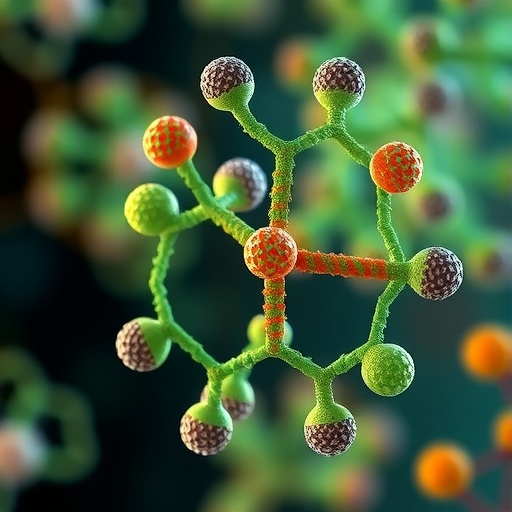In the intricate world of biochemistry, the stability of proteins within medical formulations has long been a critical challenge. For decades, amino acids have been employed as stabilizing agents, safeguarding proteins such as insulin from undesirable interactions that could compromise their function. While the efficacy of amino acids as stabilizers has been empirically recognized, the molecular mechanisms driving this effect remained elusive—until now. An international consortium of scientists, spearheaded by the Supramolecular Nano-Materials and Interfaces Laboratory at EPFL’s School of Engineering, has unveiled a groundbreaking explanation that redefines our understanding of molecular stabilization in solution.
Traditionally, it was postulated that amino acids exert their protective influence on proteins through biological means, specifically by preventing misfolding via interactions tailored to biological systems. However, this recent study overturns that assumption. The research elucidates that the stabilizing role of amino acids transcends biological specificity and instead emerges from fundamental physical chemistry principles that govern colloidal interactions. These findings pivotally shift the paradigm by revealing that all small molecules in solution possess intrinsic colloidal effects that modulate the interactions of larger particles such as proteins.
The team’s approach involved dissecting the complex interplay between proteins and amino acids by examining the solution environment as a dynamic system of particles of varying sizes and interaction potentials. Central to their discoveries is the concept of “screening attraction,” a phenomenon where small molecules diminish the effective attractive forces between larger particles in solution. To visualize this, Francesco Stellacci, head of the laboratory, offers an analogy involving two colleagues walking towards each other in a hallway: in an empty corridor, the two easily spot one another and engage, but a crowded hallway prevents their interaction. Here, amino acids act as the metaphorical crowd, physically impeding the closeness between proteins.
This principle of screening attraction is complementary to a known, yet contrasting effect attributed to salts, which have historically been understood to “screen repulsion.” Salts, through their charged ions, shield repulsive electrostatic forces between similarly charged protein surfaces, facilitating proximity and interaction. However, amino acids inversely mitigate attractive forces, a discovery that sheds light on why these small molecules are exceptional stabilizers. This “anti-salt” behavior means amino acids contribute to maintaining the dispersion of proteins by effectively reducing their propensity to clump or aggregate.
The implications of this discovery extend deeply into biological systems. For example, it has been observed in plant biology that exposure to saline environments triggers an increased biosynthesis of amino acids, presumably as a protective response to the destabilizing influence of salt on cellular proteins. Understanding this molecular mechanism offers profound insights into stress responses at the cellular level and reveals previously unappreciated strategies that organisms employ to preserve protein function under adverse environmental conditions.
From a practical standpoint, this work urges a re-evaluation of experimental protocols in biomedical research and industrial formulations. It advocates for meticulous reporting of amino acid concentrations, akin to the already-standard practice of reporting ionic strengths in solution chemistry. Overlooking the concentration and identity of stabilizing small molecules in experimental setups may obscure reproducibility and the interpretation of biochemical phenomena, especially in protein therapeutics development where stability is paramount.
The study’s pioneering perspective also opens avenues for predictive design in protein stabilization. Leveraging the newfound understanding of small molecule-colloid interactions, researchers, including Stellacci himself through his ERC Advanced Grant, aim to develop computational and experimental tools to forecast which small molecules can optimally stabilize specific proteins. Such predictive capabilities would drastically reduce the current dependency on time-consuming trial-and-error methods, accelerating the formulation of stable biopharmaceutical products, enhancing drug efficacy, and reducing production costs.
Technically, this research sits at the intersection of colloid science, physical chemistry, and biophysics. The experimental methodologies applied involved precision measurements of macromolecular interactions modulated by varying concentrations and species of small molecules in solution. The findings underscore the significance of entropic and enthalpic contributions mediated by the spatial distribution of amino acids around proteins, influencing the net interaction potentials that govern colloidal stability.
This study’s publication in Nature marks a milestone in molecular science, bridging fundamental colloidal theory with practical biological and pharmaceutical applications. It also illustrates the power of international collaboration spanning institutions such as EPFL, MIT, and the Southern University of Science and Technology in China, uniting expertise to unravel complex biochemical puzzles that have persisted through decades of investigation.
In conclusion, the revelation that amino acids function as colloidal “screens” reframes our understanding of protein stabilization literally at the molecular level. By balancing the forces of attraction and repulsion through these small molecules, cells—and by extension, medical formulations—may finely tune protein behavior, preventing aggregation and misfolding. This discovery not only holds promise for enhancing drug stability but also provides a conceptual scaffold for exploring how cellular environments can be engineered or modulated to maintain protein homeostasis.
As research progresses, the scientific community anticipates further exploration into the nuanced roles of small molecules in colloidal systems and their broader impact across life sciences and materials chemistry. This paradigm shift underscores the subtle yet profound ways in which molecular-scale interactions dictate biological function, informing both fundamental science and translational medicine for years to come.
Subject of Research: Stabilizing effect of amino acids on protein and colloidal dispersions
Article Title: Stabilizing effect of amino acids on protein and colloidal dispersions
News Publication Date: 10-Sep-2025
Web References:
https://www.nature.com/articles/s41586-025-09506-w
References:
Mao, T., Alexander-Katz, A., Luo, Z., Ong, Q., Stellacci, F., et al. (2025). Stabilizing effect of amino acids on protein and colloidal dispersions. Nature. DOI: 10.1038/s41586-025-09506-w
Image Credits:
2025 SuNMIL EPFL CC BY SA
Keywords
Biomolecules, Protein functions, Chemical mixtures, Materials
Tags: amino acids as stabilizersbiochemistry research breakthroughscolloidal interactions in biologydynamics of protein formulationsfundamental physical chemistry principlesimportance of colloidal effects in biochemistryinteractions between proteins and amino acidsmolecular stabilization in solutionprotein stabilization mechanismsredefinition of molecular stabilizationrole of small molecules in proteinssmall molecules in biochemistry





